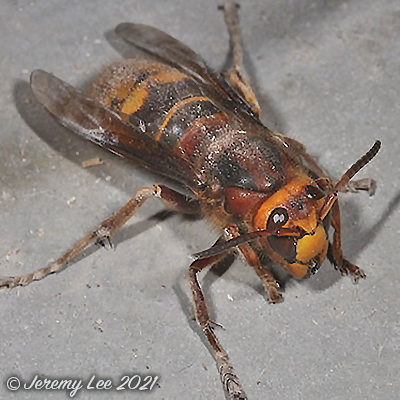
 |
|
Scientific Classifications explained » Amphibians » Ants » Aphids » Bees » Beetles » Birds » Bugs » Butterflies » Caterpillars » Damselflies » Dragonflies » Earwigs » Flies » Frog/Leafhoppers » Fungi » Galls » Grasshoppers » Harvestmen » Hoverflies » Lacewings » Ladybirds » Leaf Mines » Lichens » Mammals » Millipedes » Mosses » Moths » Sawflies » Slugs » Snails » Spiders » Trees & Shrubs » Wasps » Wild Flowers » Woodlice » Postboxes |
UK Nature > Wasps > Vespa crabro

Scientific Name: Vespa crabro Common Name: European Hornet Vespa crabro, more commonly known as the European Hornet, occurs in many parts of England and Wales, extending from Cornwall to Kent and northwards to Yorkshire. From the 1970s, hornets spread to the north Midlands and Yorkshire: previous records for these localities were at the beginning of the 20th century. It is found in many lowland habitats, but particularly associated with ancient deciduous woodland. Also associated with houses and outbuildings in farming areas and sometimes in more urban situations. Queens emerge from their overwintering sites from early April and the first workers emerge from late June to early July. Males and females mainly emerge during September. The prey of hornets includes other species of social wasp, honey bees, flies, butterflies, moths (hornets can forage in moonlight) and spiders. Prey are often taken from flowers and the vegetation of trees. |
|

https://www.uknature.co.uk is a website dedicated to showing the immense diversity of UK nature and wildlife. Our vast range of habitats, from lowland arable to snow covered mountains, from storm-ravaged coastlines to peaceful inland freshwater lakes and rivers, from dry, sandy heaths to deciduous and coniferous forests, all these habitats contribute to the abundance of UK nature. We have wild birds in huge numbers either residing or visiting our shores (597 recorded species as at July 2013) and we must also not forget the humble back garden with its grass lawns, flower beds filled with nectar rich flowers, shrubs and trees, all designed to attract huge numbers of insects such as bees, moths, butterflies and hoverflies; and finally the small ponds which provide safe havens for frogs, toads, newts and even slow worms and grass snakes. www.uknature.co.uk is the showcase for my personal passion, photographing uknature in all its glory. I sincerely hope you all enjoy the fruits of my labours. This site and all images contained therein is © Jeremy Lee 2004 - 2025. All Rights Reserved. Site design by Jeremy Lee. Site development & IT Support by Stuart Lee. |